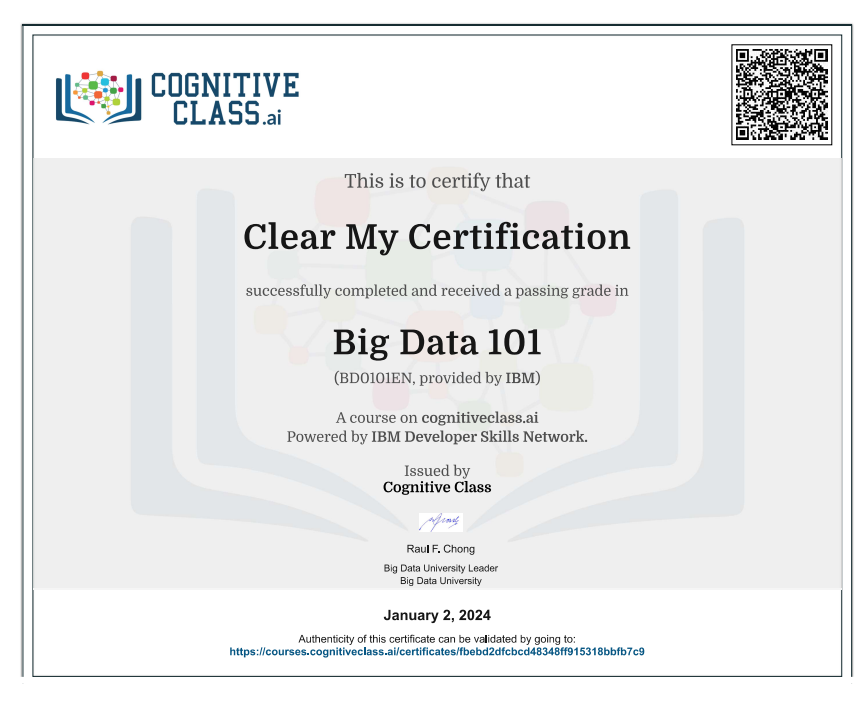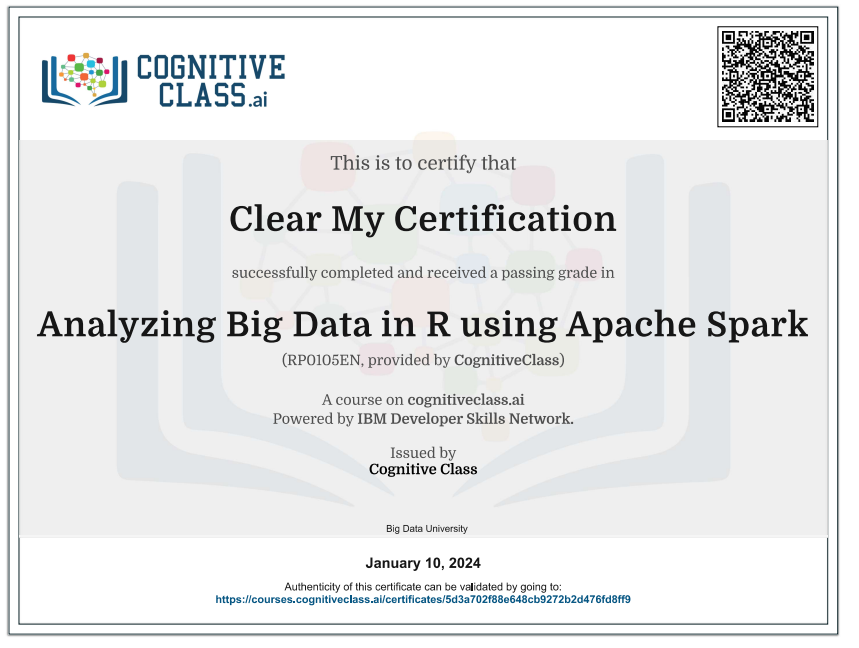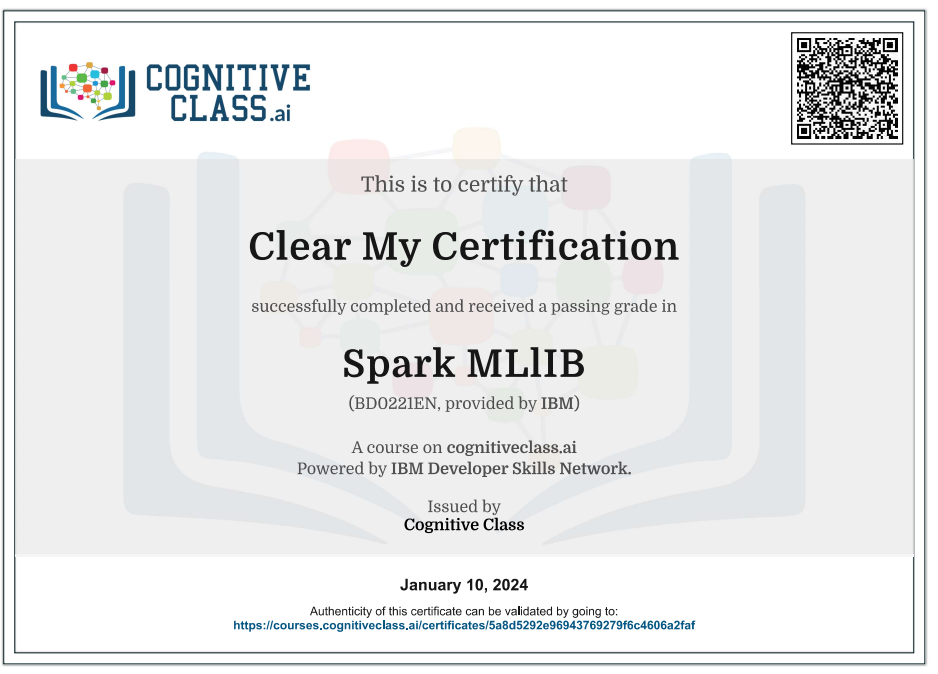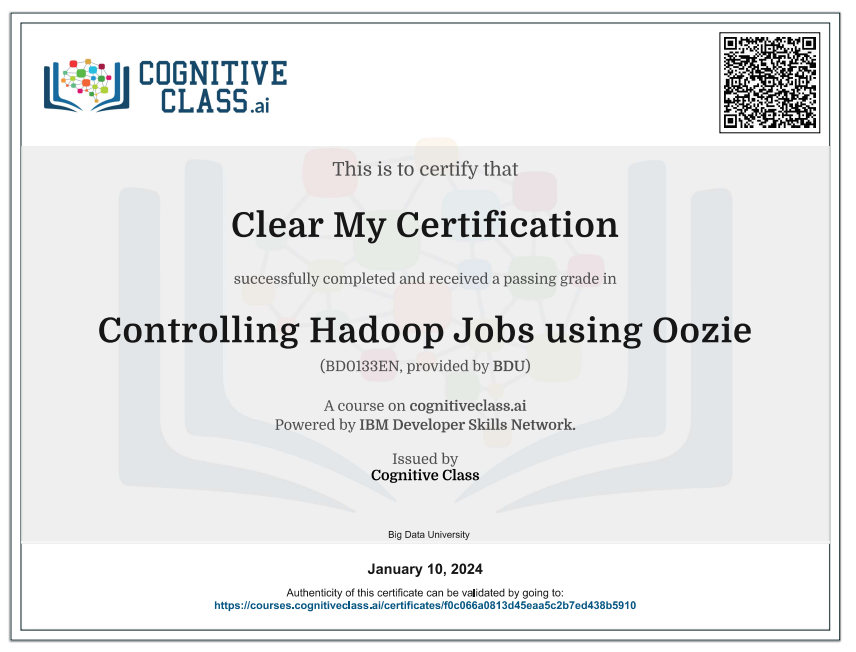Enroll Here: Big Data 101 Cognitive Class Exam Quiz Answers
Big Data 101 Cognitive Class Certification Answers

Module 1 – What is Big Data Quiz Answers – Cognitive Class
Question 1: Name one of the drivers of Volume in the Big Data Era?
- Scalable infrastructure
- Cost
- Competitive advantage
- FinTech
- Research and development
Question 2: Value from Big Data can be _______________?
- Profits
- Veracity
- Petabytes
- Technical ability
- Infrastructure
Question 3: In the video, 2.5 Quintillion Bytes of data are equivalent to how many blue ray DVDs?
- 1 Billion
- 10 million
- 100 million
- 5 million
- 1 Trillion
Module 2 – Big Data – Beyond the Hype Quiz Answers – Cognitive Class
Question 1: How many petabytes make up an Exabyte
- 32
- 2020
- 64
- 1024
- 8
Question 2: What is an example of a source of Semi-Structured Big data?
- Cameras files
- Relational databases
- Satellite files
- Spreadsheet file
- JSON files
Question 3: When is it estimated that the data we create and copy will reach around 35 zettabytes?
- We have already surpassed this mark
- 2050
- 2030
- 2040
- 2020
Module 3 – The Big Data and Data Science Quiz Answers – Cognitive Class
Question 1: What is the process of cleaning and analyzing data to derive insights and value from it?
- Machine Learning
- Exploratory Research
- Data Science
- Predictive Modeling
- Decision Trees
Question 2: What is the search engine used by Walmart?
- JSON
- HBase
- ZooKeeper
- Polaris
- Poisson
Question 3: An example of visualizing Big Data is___________?
- Hadoop
- Integration
- Agile Governance
- Temperature on a map
- Closing your eyes and imagining it
Module 4 – Big Data Use Cases Quiz Answers – Cognitive Class
Question 1: What is the term used to describe an holistic approach that takes into account all available and meaningful information about a customer to drive better engagement, revenue and long term loyalty?
- Enhanced 360-degree view
- Big Data Exploration
- End to End
- Operations Analysis
- Customer Retention
Question 2: What can help organizations to find new associations or uncover patterns and facts to significantly improve intelligence, security and law enforcement?
- Using local servers
- Analyzing data in-motion and at rest
- Satellite data
- GPS coordinates
- Using XML
Question 3: In Operations Analysis, we focus on what type of data?
- Location Data
- Machine Data
- Binary Data
- Social Media Data
- Structured Data
Module 5 – Processing Big Data Quiz Answers – Cognitive Class
Question 1: What is a method of storing data to support the analysis of originally disparate sources of data?
- Data Lakes
- Data Mining
- Predictive Analytics
- Data Analytics
- Deep Learning
Question 2: Data Warehouses provide online analytic processing: True/False
- False
- True
Question 3: What does ‘OLAP’ stand for?
- Online Analytical Prediction
- Online Analytical Platform
- Online Analytical Processing
- Online Advanced Prediction
- Online Advanced Programming
Big Data Final Exam Answers – Cognitive Class
Question 1: In Module 1: What is a common use of big data that is used by companies like Netflix, Spotify, Facebook and Amazon?
- Recommendation Engines
- Data Lakes
- Clusters
- The Cloud
- Sensors
Question 2: In Module 2: Is one byte binary? True/False
- False
- True
Question 3: In Module 2: What has highly contributed to the launch of the Big Data era?
- Clusters
- Spark
- Cloud Computing
- Zetabytes
- Data Scientists
Question 4: In Module 3: A data scientist is a person who is qualified to derive insights from data by using skills and experience from computer science, business or science, and statistics. True/False
- False
- True
Question 5: In Module 3: ‘HDFS’ stands for ____________________?
- Hadoop Data Fraud System
- High Data File System
- Hadoop Distributed File System
- High Distribution Frequency System
- High Definition Frequency Sensors
Question 6: In Module 3: Data privacy is a critical part of the big data era. Businesses and individuals must give great thought to how data is _____________________________.
- collected, retained, used, and disclosed
- bought, sold, stored and analyzed
- secured, sold, downloaded and uploaded
- aggregated, compiled, saved and stored
- stored, analyzed, read and written
Question 7: In Module 5: In the Hadoop framework, a rack is a collection of ____________?
- Yarn
- Networks
- Bits
- Nodes
- Distributed files
Question 8: In Module 5: What is a method of storing data to support the analysis of originally disparate sources of data?
- Spark
- Data Warehouse
- Yarn
- Data Repository
- Data Lake
Question 9: In Module 5: The Hadoop framework is mostly written in the Java programming language. True/False
- False
- True
Question 10: In Module 5: What is the term referring to a database that must be processed by means other than just the SQL Query Language.
- Spark
- NoSQL
- Python
- SQL
- Hadoop
Introduction to Big Data 101
Big Data refers to extremely large and complex datasets that cannot be effectively processed, managed, or analyzed using traditional data processing tools or methods. The concept of Big Data is characterized by the “3 Vs”:
- Volume:
- Big Data involves a massive amount of information. This can be data in petabytes, exabytes, or even larger.
- Velocity:
- Refers to the speed at which new data is generated, collected, and processed. In many Big Data scenarios, data is generated in real-time or near-real-time.
- Variety:
- Big Data encompasses diverse types of data, including structured data (e.g., databases), unstructured data (e.g., text, images, videos), and semi-structured data (e.g., JSON, XML). Dealing with this variety of data types poses additional challenges.
Additionally, some versions of the Big Data concept include two more Vs:
- Veracity:
- Refers to the reliability and trustworthiness of the data. Big Data sources often involve data from social media, sensors, and other sources, which may have varying levels of accuracy.
- Value:
- The ultimate goal of Big Data is to extract value and insights from the massive amount of data. This involves analyzing and interpreting the data to make informed business decisions, discover patterns, and gain a competitive advantage.
To handle Big Data, organizations often employ specialized tools, technologies, and frameworks that are capable of distributed computing and parallel processing. Some popular Big Data technologies include:
- Hadoop:
- An open-source framework that allows distributed processing of large datasets across clusters of computers. It includes the Hadoop Distributed File System (HDFS) and MapReduce programming model.
- Apache Spark:
- A fast and general-purpose cluster-computing framework for Big Data processing. It provides high-level APIs in Java, Scala, Python, and R.
- NoSQL Databases:
- Non-relational databases designed for handling large volumes of unstructured or semi-structured data. Examples include MongoDB, Cassandra, and Couchbase.
- Data Warehousing Solutions:
- Traditional data warehouses and newer cloud-based data warehouses like Amazon Redshift, Google BigQuery, and Snowflake, capable of handling massive datasets for analytics.
- Machine Learning and AI:
- Big Data is often leveraged in conjunction with machine learning and artificial intelligence to extract meaningful insights, patterns, and predictions from the data.
Big Data analytics has applications across various industries, including finance, healthcare, e-commerce, telecommunications, and more. It enables organizations to make data-driven decisions, improve operational efficiency, enhance customer experiences, and gain a competitive edge in the rapidly evolving digital landscape.
 Clear My Certification All Certification Exam Answers
Clear My Certification All Certification Exam Answers



